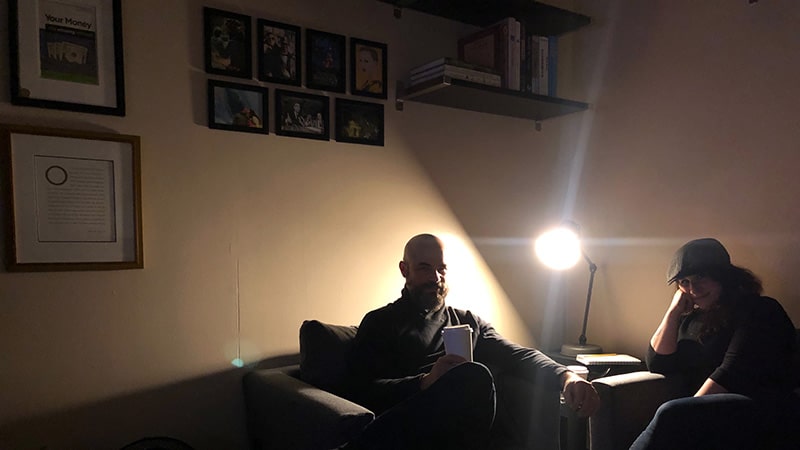A couple of weeks ago, I stopped in to visit Prosperity Pie Shoppe, a local dessert and coffee place co-owned by Luna Jaffe. Jaffe is a sort of wonder woman who blends art, psychotherapy, and financial education into something she calls “wild money”. The space that Luna and her partners own isn’t only a source of tasty treats; it’s also a studio for money coaching.
Over pie and coffee, I chatted with Luna and one of her money coaches, Dryden Driggers. We shared our backgrounds with each other and talked about the direction we’d like to take our work. I think the three of us have a lot of shared viewpoints and visions. I imagine we’ll find ways to work together in the future.
Giving Every Dollar a Job
One thing stuck with me from our talk, though. We were discussing how to actually reach people who want financial help. When people come to us ready to dig out of debt and build wealth, what specific ideas are effective “triggers” or “switches” that change how they manage money?
“In my work,” I said, “I’ve found that getting people to focus on saving rate — the gap between their earning and spending — can make a big difference. In the financial independence community, many people receive this spark of inspiration when they read Mr. Money Mustache’s article about the shockingly simple math behind early retirement. It’s all about how powerful a high saving rate can be.”
“We’re not working with people who are thinking about early retirement,” Dryden said. “Some of the people we coach are well off, it’s true, but many are just starting out. They’re deep in debt. They’re living paycheck to paycheck. They’re simply grasping for a lifeline.”
“Right,” said Luna. “And for these folks, budgeting is vital. We’ve had great success steering folks to You Need a Budget. Even if they don’t use the software, we want them to understand the YNAB philosophy because it can be so powerful.”
“Exactly,” said Dryden. “I think the one thing that really helps the people we coach is the idea that you should give every dollar a job. That’s the first rule of YNAB.”
Growing the Gap
On Saturday, I met with my friends Wally and Jodie again to talk about their financial journey. Since our first meeting in August 2018, this couple has made significant progress toward paying off their debt and establishing a solid financial future. They wanted a check-in to make sure they’re still on course.
It was interesting to listen to what Wally and Jodie had to say, to pick up on the financial concepts that seem to have clicked with them.
- They’ve bought into the debt snowball and have used that technique to eliminate all but their three largest debts. They have a car loan, a motorcycle loan, and some school debt remaining.
- They’ve been trying to keep in mind the balanced money formula, the broad budget framework in which you allocate no more than 50% of your spending to Needs, set aside at least 20% to Saving (and Debt Reduction), then use about 30% for Wants. (In fact, they’ve been telling people in Jodie’s family about this system!)
- Most of all, they’ve latched on to the idea of “growing a gap” between earning and spending. Wally and Jodie pay attention to how much this gap is every single month — and their biggest challenge is deciding how to allocate the gap.
“We find that the gap can cause problems,” Jodie said. “When it’s especially wide, we get giddy and end up spending too much.”
“But we’re glad to have that gap there,” Wally said. “I’ve never had a gap in my life. It’s crazy to think that we’ve had one for almost a year now.”
“We just need help deciding what to do with it,” Jodie said.

Wally and Jodie, the first guests in the brand-new GRS office space
Our talk on Saturday revolved around their options. They could use this “gap” money to accelerate debt payments. They could set it aside for other savings goals. Or they could mix it up. In the end, I think they decided to use their gap to do two things. First, increase their emergency fund from $1000 to $3000 or $5000. Second, set aside $400 per month into an opportunity fund (although we never used that term).
Their opportunity fund would allow Wally and Jodie to defer making a decision about how to allocate their gap money for a while. If they decide to use it to accelerate debt repayments, they can. If they decide to use it to travel, they can. If they decide to use it to beef up their emergency fund, they can.
Do What Works for You
My conversations with Luna and Dryden and Wally and Jodie — and my recent family meeting with Kim — has reinforced my belief that each person has a unique set of skills and unique psychological makeup. And because we’re different, we’ll each be drawn to different aspects of money management.
Kim, for instance, hates tracking spending (or anything else). She’s never going to build a budget or use a tool like Personal Capital. But Kim comes equipped with built-in frugality. Plus, she’s a hard worker who is willing to pick up extra shifts in order to make more money. And if she can automate good behavior — such as funneling IRA contributions into index funds — she’ll gladly do so.
I, on the other hand, love tracking my money. I want to manually enter transactions into Quicken. And while I’m not naturally frugal — I’m a natural spendthrift, actually — by tracking my money, I’m able to spot problem areas and make corrections. Plus, I’m good at creating income streams. My income streams are never large, but I have many of them.
It’s as if money management is a buffet. There are a wide variety of effective tools available to help you meet your financial goals. It’s your responsibility to browse this buffet, then to think about what it is you want to accomplish and consider your own tendencies and inclinations.
Using this info, pick a few techniques to try. Some will work for you. Some won’t. Don’t get discouraged if some piece of smart advice doesn’t suit your situation. That’s okay. Simply return to the buffet and pick another option!
For more than thirteen years, the unofficial motto of getting Rich Slowly has been “do what works for you”. There’s no one right way to achieve financial success. There are some best practices, sure, but sometimes the “best” way to do something isn’t the most effective way for you…or for me.
Author: J.D. Roth
In 2006, J.D. founded Get Rich Slowly to document his quest to get out of debt. Over time, he learned how to save and how to invest. Today, he’s managed to reach early retirement! He wants to help you master your money — and your life. No scams. No gimmicks. Just smart money advice to help you reach your goals.




Recent Comments